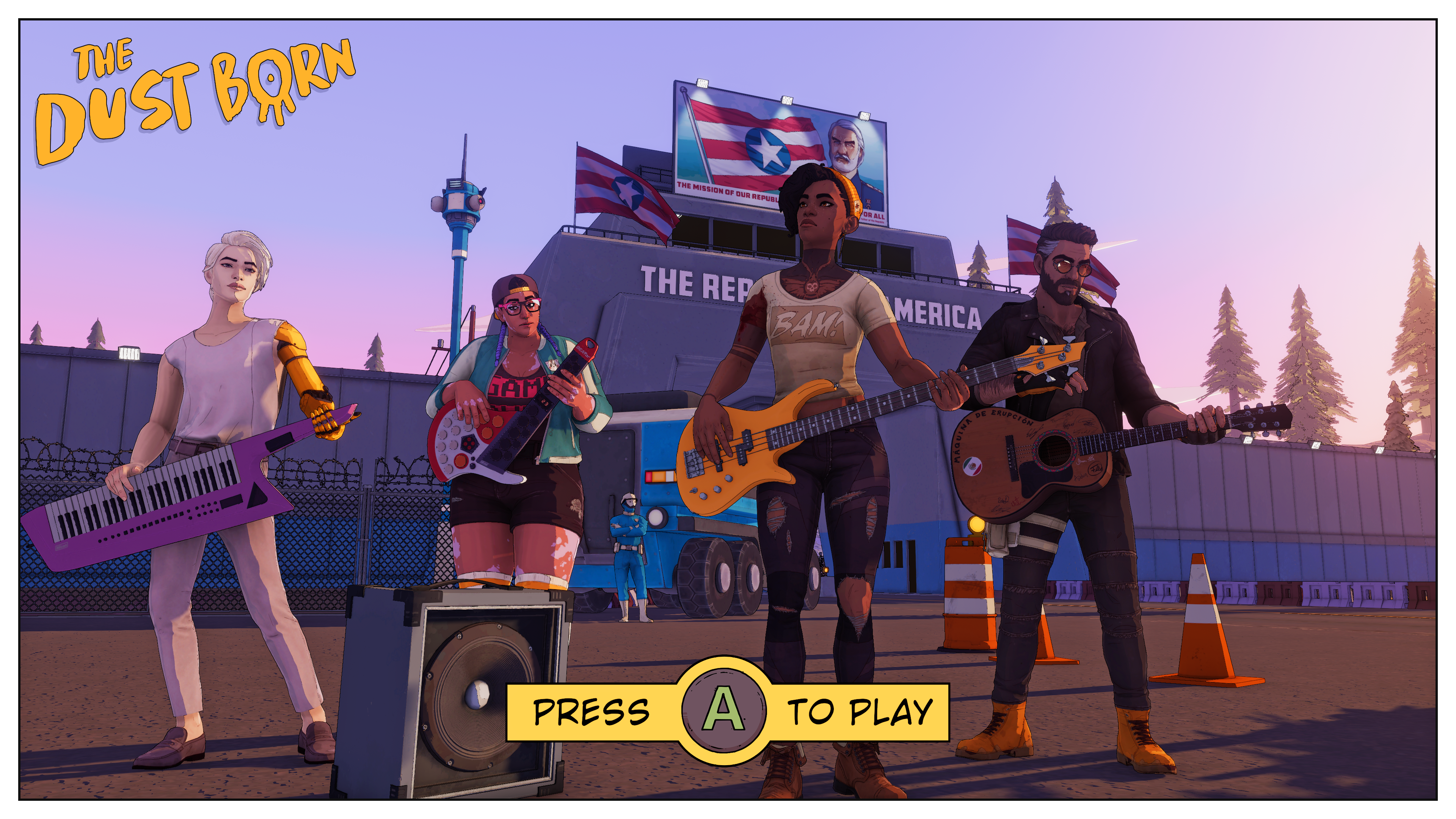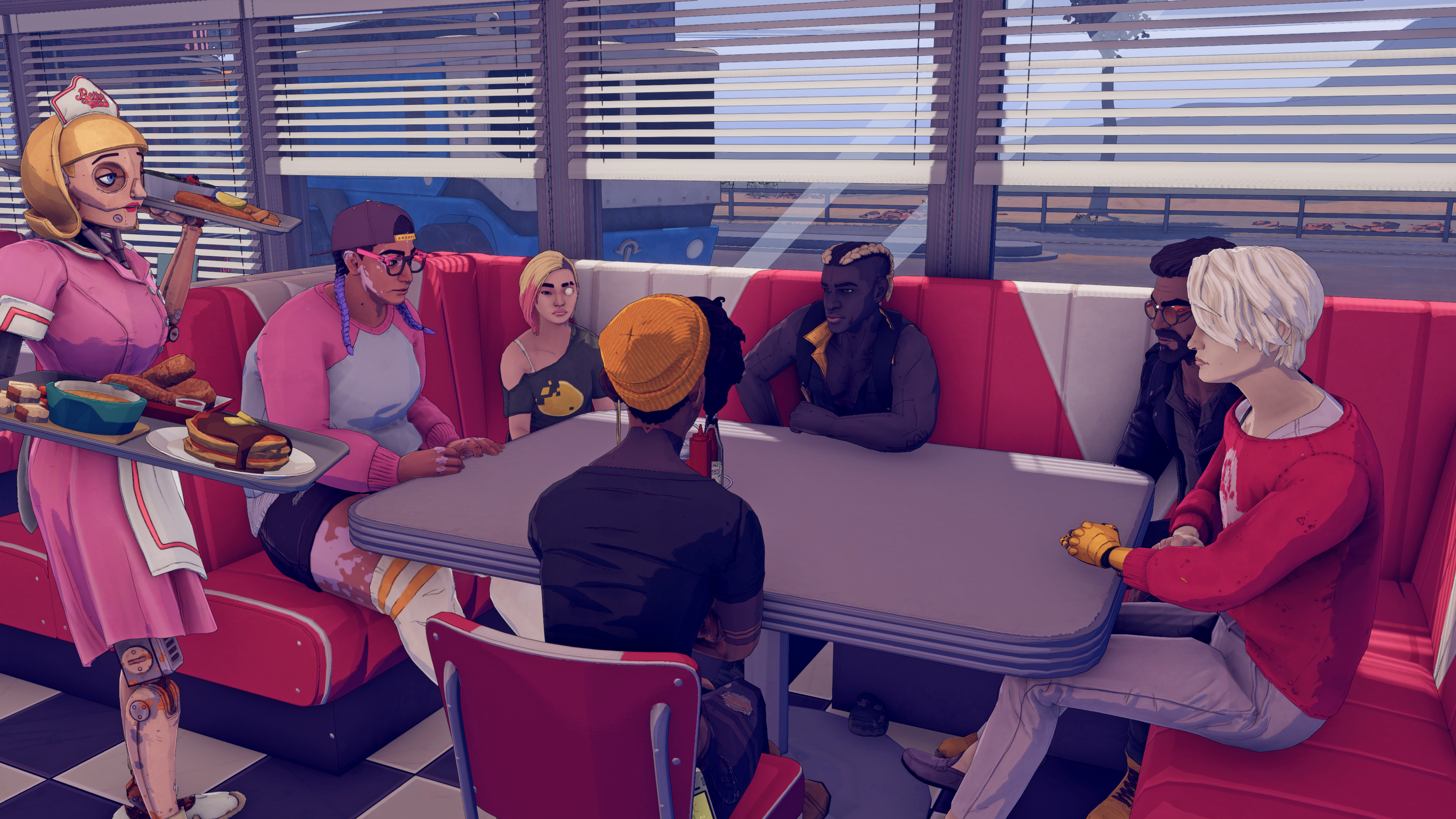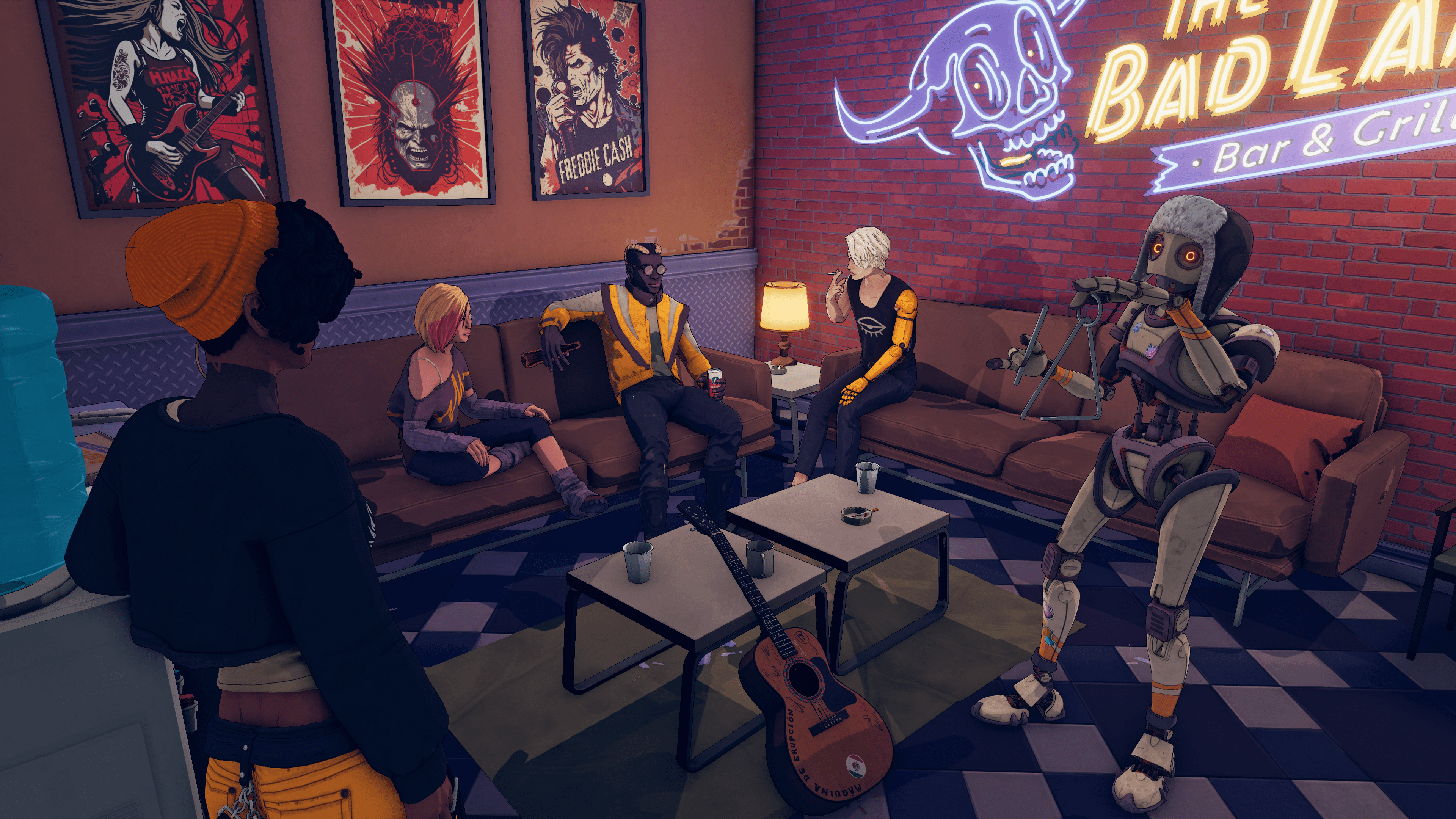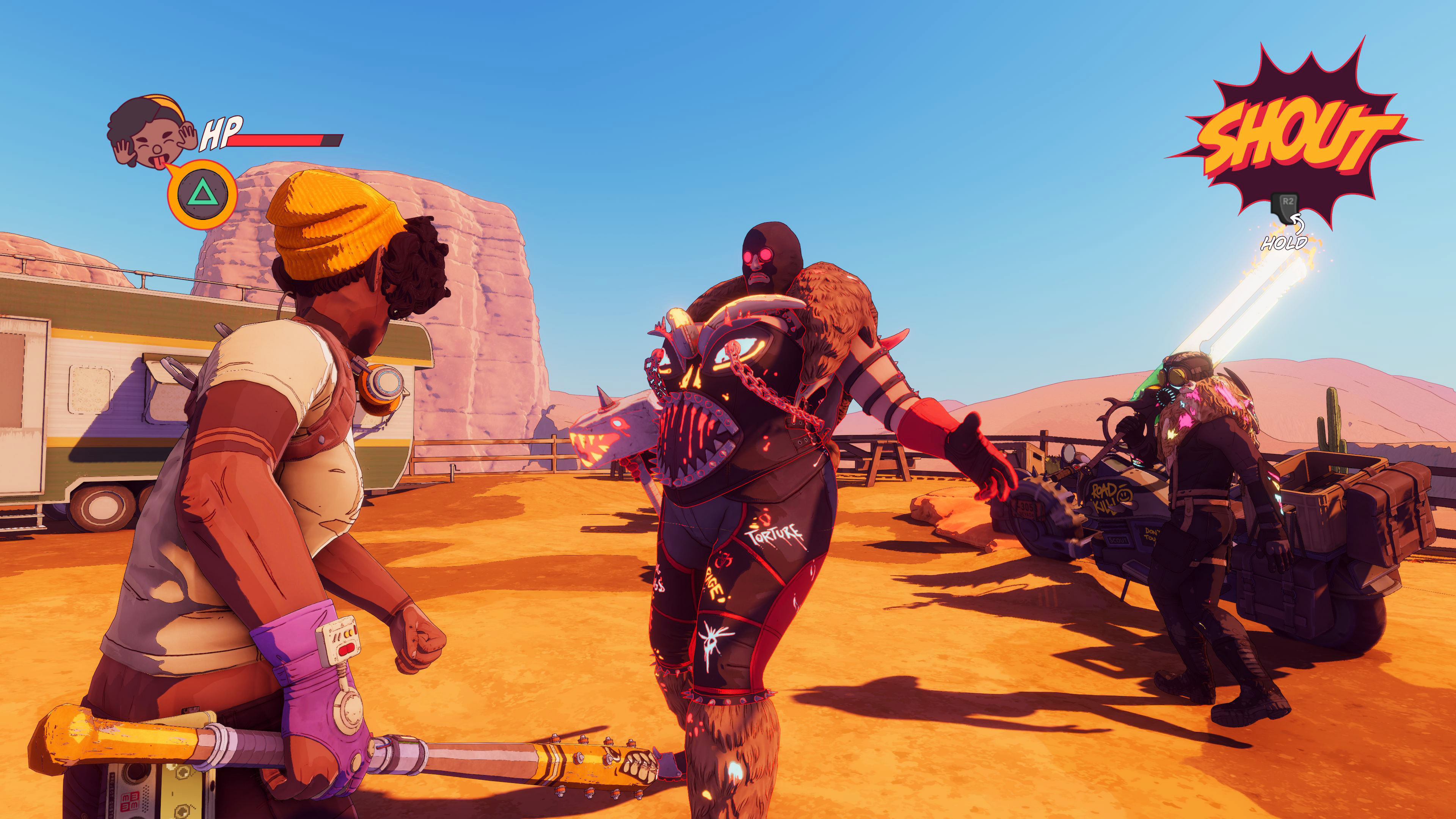
One of the first tutorial messages that pops up on the screen in Dustborn is a warning that what you say in conversations will affect your relationship with other characters, but that there’s “no wrong answer” to pick. Introduced as a story-driven experience shaped by your choices, Dustborn riffs on the Telltale-esque formula by having everybody remember your deeds. The concept, however, is taken a step further, since your actions also impact how you and other characters develop over time. Developed by Red Thread Games and published by Spotlight, Quantic Dream’s publishing branch, the result is an ambitious story that often gets tangled in its aspirations, yet does so without ever abandoning its heartfelt nature.
The road-trip story begins with a group of four 30-year-olds inside a minivan, making their escape after a heist. The mission is to make it across an alternate-reality version of the United States to eventually deliver their stolen package in Nova Scotia, Canada. Your biggest obstacle is avoiding surveillance from Justice, a fascist regime that’s particularly interested in persecuting Anomals. These are people who can speak certain words to invoke special powers after a mysterious event that took place decades ago. As you might have guessed by now, all four people in the van are Anomals, including protagonist Pax.
In order to attempt to make it to Nova Scotia undetected, the cover for the group is to pass as a punk-rock band, despite their music skills being rather lackluster. Making use of fake IDs and forged work permits, the road trip is dictated by gigs, which you play following a standard Guitar Hero-style minigame. When you’re not onstage, you stop at different locations to connect with members of a resistance group, rest at campsites to rehearse and catch up with characters, or compose new songs.

Throughout the 20 hours it took me to see the end credits, Dustborn’s story took a dozen different turns. At first, I was expecting it to unfold in a similar way to Life Is Strange, showcasing people who have access to supernatural abilities in largely grounded depictions of our reality. Dustborn follows this to a certain degree, yet it ultimately favors fiction more often than not.
This alternate America is dictated by the JFK assassination happening to Jackie Kennedy instead, and the various events that ensued after, including the emergence of Anomals. The game takes place in 2030, with an already-established presence of robots and an ever-present commentary about how the reliance on them sucks (a robot goes haywire and steals your vehicle, server problems almost lead to the death of a mechanic who’s stuck underneath a bus, and so on).

With each new location you visit, the world and its inner turmoil continue to expand. Justice isn’t the sole enemy; there are also the Puritans, a group of technology-obsessed fanatics from whom you stole the package, as well as another entity that shows up toward the second half of the story. The game’s story also gets into the origin of the Anomals — with lengthy expositions about the use of language that get close to listening to Skullface in Metal Gear Solid 5: The Phantom Pain — plus flashbacks to Pax’s childhood, her past relationships with some members of the crew, combat sequences, and way more in the spoiler territory. The story is always trying to cast a wider net, and in the process some threads end up underdeveloped at best and forced at worst.
One part of the game that works is its emphasis on different points of view. No matter who you’re speaking to in Dustborn, you’re free to choose the camera’s perspective. Every conversation starts with a default angle, but you can move the camera around the scene, following an invisible path until it stays in place somewhere else, creating another viewpoint.
At times, the camera might start in a place where it’s showing two characters having an intimate conversation on a bench as the rest of the group sits around a campfire in the background. Rotate it, and the scene moves to just the two of them gazing at the moonlight shining on the ocean. During a tense point in the story, the camera angle could signify a chance to rebuild trust in a group that’s been fractured by betrayal, with everybody being in the frame. Or you could change the angle to emphasize said rupture, with the culprit being isolated on one side of the screen as the others listen to them making their case.
At the heart of everything, the characters’ writing and their specific vocal powers (named Vox) are what kept me invested. From the start, it was refreshing to see such a diverse cast that largely ignores media stereotypes and includes characters who are allowed to be angry, messy, and joyful in their own ways.

While I can’t speak with authority about each of the characters’ backgrounds depicted in Dustborn, I was particularly surprised by Theo. Because he’s a Mexican character, I was fully bracing myself to hear constant Spanish quips à la Jackie Wells in Cyberpunk 2077 or the characters in Far Cry 6. Spanglish isn’t uncommon, of course, but as a fellow Latin American, it was gratifying to see Theo following the rule of thumb: When you’re surrounded by English-speaking folks, you have to stick to English to be understood. It was only during moments of surprise that Theo let out a Spanish phrase, until a later sequence where he makes a phone call to a relative. Seen from Pax’s perspective, if you choose to eavesdrop, the subtitles display the conversation in Spanish, while Pax’s thought bubbles “translate” the main bits of it. I’m glad I didn’t have to witness yet another “[ominous mumbling in Spanish]” caption.
The care from the development team for each character is tangible, and speaking to them every chance I had became an imperative after I saw how their personality archetypes could be molded by different actions and conversations. Theo, for example, can stick to his role as the group leader or slowly open up and become more a part of the team, with the lack of impartiality that doing so involves. This feature isn’t flawless, however — while your actions have weight, some of the default story beats feel intrusive, and not always in the best way.
In one instance, a character departed the group after a rant, even though we had had a conversation the night before about how much their relationship with Pax had improved. More often than not, my hand was forced to use Pax’s Vox with the crew, such as bullying or momentarily blocking them off from speaking, despite the clear consensus among the characters that doing so is invasive. These moments didn’t completely obfuscate my sense of player agency — stories need structure, after all — but they did remove the weight of some of my previous actions.
There are ways in which Dustborn challenges its own conventions, such as having other characters use their Vox with Pax without you having a way to prevent it. The one that stood out to me the most was the existence of limited-time dialogue options. The more you listen to certain conversations, the more options appear over time. Meanwhile, the older ones expire. It made me reflect on the importance of knowing when to interrupt someone and when it’s time to just shut up and listen to the other person without saying a word, letting them vent after a stressful event.

Around the midpoint of the story, there’s a conversation with the group in which you’re told how many times you actually listened to somebody, and the impact of your seemingly small actions. After all, throughout the game, small actions can change how scenes unfold. It was funny to see the characters’ dinner end up a bit burned because I had helped the robot in charge of it pick a hat as they were figuring out their identity. I succeeded in healing Pax’s bond with a family member, only for them to ultimately lean on their idealist archetype and follow their own path instead. I chose to support this decision despite knowing they’d eventually part ways with Pax as a result, and it felt good to have that option available.
The biggest culmination of your decisions happens at the very end, when you don’t have a “select your ending” prompt. Instead, a message on the screen says that your choices and actions have been informing how the story would end the whole time. You get to watch Pax’s decision unfold without your input, and who decides to stick with her for what comes next.
As much as Dustborn leans into its science fiction setting, its story is told from a viewpoint that has clear parallels to reality. There are nods to jokes like “my husband and I saw you from across the bar” as well as mentions of “woke mind virus” speeches and how blatantly stupid they are. One of Pax’s Vox even allows her to “cancel” somebody — which is a bit on the nose, considering the contrast between Dustborn‘s queer and BIPOC characters against Quantic Dream’s alleged misogynistic and homophobic responses to a lawsuit alleging the studio was a toxic workplace.
As a whole, Dustborn is as messy and imperfect as the characters you come across. The story beats can be intrusive, and there are multiple threads left unresolved. But it makes sense to not have input on everything, to only have so much influence over the people around you. Dustborn is a reminder of how seemingly innocuous gestures might not always have a tangible impact, but they’re always shaping who we are and how we relate to others. In a game informed by decisions, the most gratifying choices didn’t involve a right answer — they were about getting a different perspective.
Dustborn was released Aug. 20 on PlayStation 4, PlayStation 5, Windows, Xbox One, and Xbox Series X. The game was reviewed on PlayStation 5 using a pre-release download code provided by Spotlight by Quantic Dream. Vox Media has affiliate partnerships. These do not influence editorial content, though Vox Media may earn commissions for products purchased via affiliate links. You can find additional information about Polygon’s ethics policy here.
